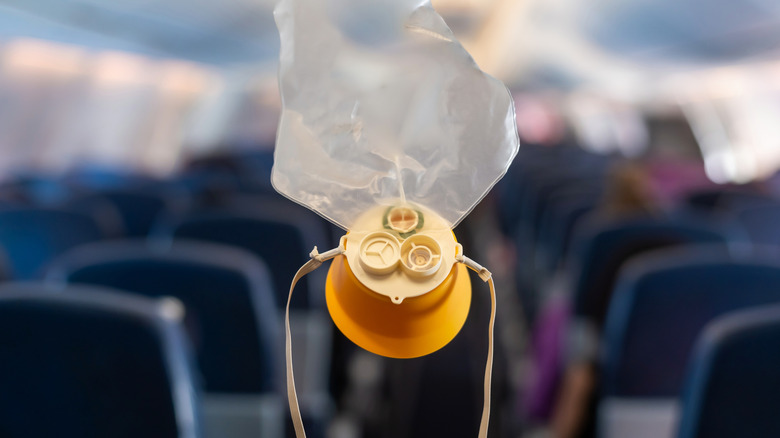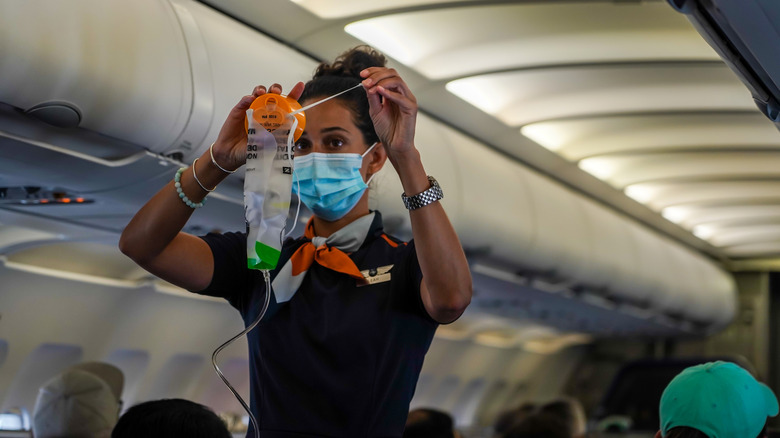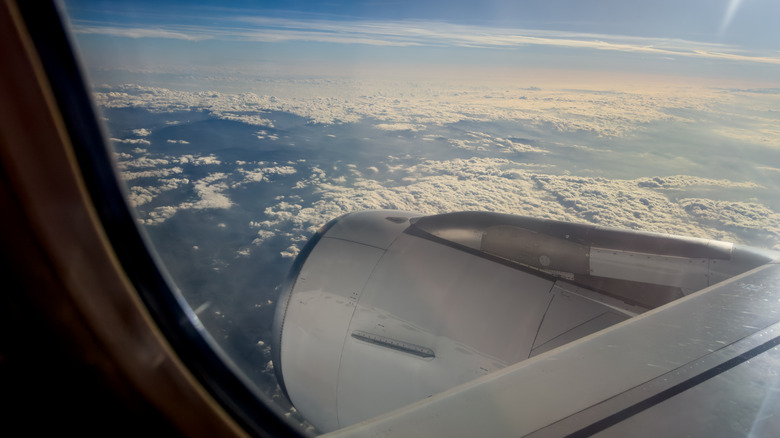Airline Oxygen Masks Only Have About 15 Minutes Of Air - Here's Why That's Plenty
Yes, we know that flying is typically considered the safest way to travel. This doesn't change the fact that we're hurtling along tens of thousands of feet in the air, in a vehicle that still seems utterly improbable even if you understand the logistics of how airplanes fly. What the average passenger doesn't tend to know, though, is the extent of the safety precautions taken on their behalf. Take the oxygen masks, for instance. You've probably heard the cabin crew explain, during the pre-takeoff demonstration, that they'll drop down from storage above the seats in the unlikely event that they'll be needed. A fact that's sure to surprise travelers is that these masks contain just 10-20 minutes or so of oxygen. This may not sound like nearly enough to be of practical use, but you can rest assured that it's actually an ample supply.
The purpose of these masks isn't to provide air for the user all the way from the point at which the aircraft first experienced an issue back down to the ground. All the aircraft has to do in the case of a drop in cabin pressure is descend to a point at which it's easier to breathe. The reason this supplemental oxygen can be so important to flyers is the same reason why it's so important to mountaineers: the higher you go, the thinner the air becomes. Get to a lower altitude, and the need for this supplemental oxygen is greatly lessened.
How the process works
As the cabin crew emphasizes before takeoff, oxygen masks are dispensed from compartments above should the pressure in the cabin drop. The masks are constant-flow masks, which, according to the Aircraft Owners and Pilots Association, automatically deliver an oxygen supply to the user once it's put on. They're designed for quick and easy use by everyone on the aircraft, many of whom may have never used them before. The simplest, most practical solution for providing oxygen to everybody is via relatively simple masks like these. Burning iron oxide and sodium perchlorate or a similar chemical blend that results in oxygen is the key to these potentially life-saving pieces of equipment.
While everyone is fitting their masks and being supplied with oxygen, the aircraft will descend to an altitude at which it's easier to breathe freely. Because it's protocol to do so as soon as practical when a significant drop in pressure is detected, the oxygen masks may be required for only the briefest moment, if at all. Even if this is the case, though, these are situations in which it's absolutely paramount to act as quickly as possible. The effects of the thin air at high altitudes can be devastating.
The ill effects of cabin pressure failure
One of the biggest aviation advancements was the pressurized cabin. When all is working as it should, it makes the heights attained on a typical flight easier to bear. We have a tendency to complain about the less comfortable aspects of air travel, such as popping ears, but in truth, the situation could be far worse without a pressurized cabin.
Essentially, those in the aircraft are protected by a sort of bubble in which the air pressure is maintained at a level similar to that at a lower altitude of approximately 8,200 feet. The air is introduced into the cabin via the engine's compressors, and then the system reacts to keep it stable as the flight progresses. This is done to mitigate or prevent the effects of the thin air at high altitudes. If such measures weren't in place or were to fail, the passengers and crew would be at risk of hypoxia, a condition that sets in when there isn't enough oxygen in the body. Loss of consciousness, slower reaction times, and an inability to focus are just some potential ill effects of hypoxia; the longer these effects persist, the more severe they can become. This is why preventative action is so important and why the oxygen masks' supply, which may seem meager, is far longer than will be necessary in most cases.


